Table of Contents
- We recommend the Mayo Clinic Diet because it embodies the best practices of healthy living, including an emphasis on eating whole foods, limiting portion sizes, and staying physically active.
- The Mayo Clinic Diet is transparent about pricing, with plans starting at $19.99 per month and options for three and 12-month subscriptions for additional savings. That makes it more affordable than other programs we tested.
- To inform our perspective on the Mayo Clinic Diet, our tester followed the program for two weeks. The Handbook Team also conducted interviews and surveys and collected insights from healthy living experts for a well-rounded approach to this review.
As you start a weight loss journey, you may be excited about making positive changes to your lifestyle while also feeling anxious and uneasy. The process is often challenging, and it’s normal to feel apprehensive. You may consider a weight loss program if you’re committed to reaching your goals but unsure where to start.
“Weight loss platforms can offer several benefits, such as promoting healthy habits and providing a supportive community,” says Mrinal Pandit, a registered dietitian and clinical nutritionist at Oliva Skin and Hair Clinic. “However, these platforms also have some disadvantages. Many are not personalized to an individual’s specific needs and may promote restrictive diets, which can lead to nutrient deficiencies.”
When you think about healthy living, you may focus mostly on weight loss. But really, it’s much more than that—it’s about building healthy habits, learning about nutrition, and being physically active in ways you enjoy. We tested the Mayo Clinic Diet (MCD) to see if this diet program can help you reach those goals.
For the most part, the Mayo Clinic Diet practices what they preach: The diet is simple, effective, and approachable for many people, especially those without foundational knowledge about nutrition. However, some elements were lacking, especially when it came to guidance, support, and accessibility.
HelpGuide Handbook for the Mayo Clinic Diet program
If you only learn five things about the Mayo Clinic Diet, this is what you need to know.
Our testing experience
Our Handbook Team hand-tests every weight loss platform we review so we can feel confident recommending the best program for our readers. We completed the sign-up process for each platform and tested them for two weeks.
During that time, we logged our progress, cooked the recommended recipes or ate the provided meals, attended workshops, completed educational lessons, and interacted with health coaches and customer service representatives.
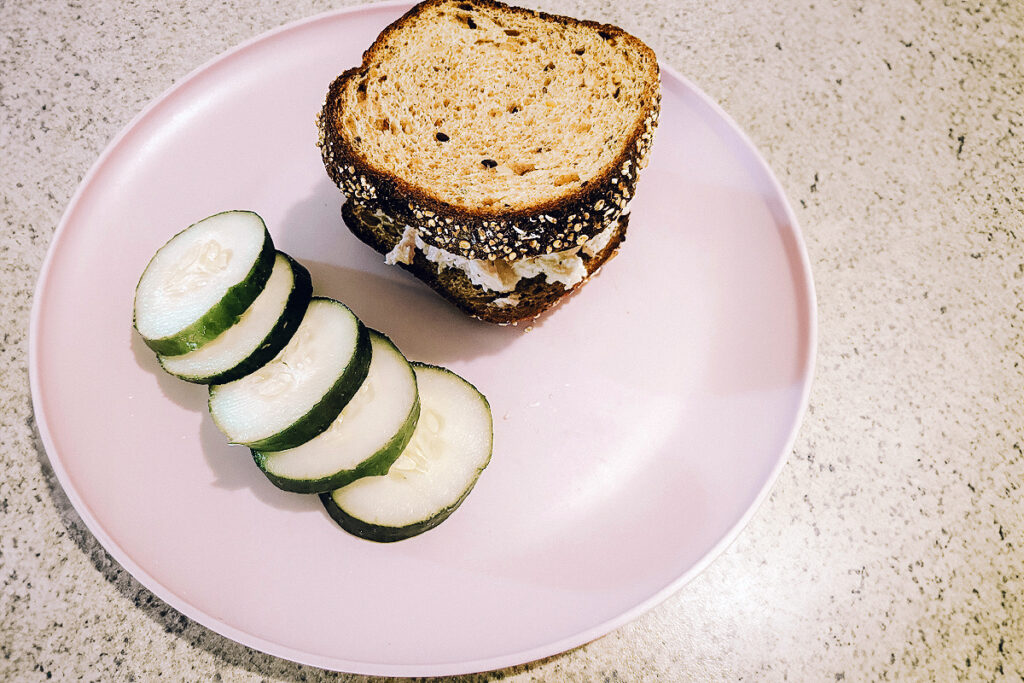
We conducted a focus group and also surveyed 600 people who have used weight loss platforms to learn more about the user experience. We also consulted with dietitians, nutritionists, and psychologists to vet our choices and help us better understand the nuances of how mental health and nutrition are related and how certain weight loss programs can play a positive role in supporting both.
By compiling our testing data, interview and survey results, and insights from healthy living experts, we developed a thorough perspective on the platform.
Learn more about our healthy living review methodology.
Why Helpguide cares about healthy eating




Healthy living, including a balanced diet and regular physical activity, is directly related to your mental health and overall wellness. Eating a well-balanced diet can help reduce symptoms of depression, lower your risk of chronic diseases, like heart disease or type 2 diabetes, and strengthen your bones and muscles. Physical activity can ease symptoms of anxiety and depression, help you sleep better, and enhance your thinking, learning, and judgment skills.
We understand that weight loss can be a difficult subject. It’s often fraught with negative emotions that can directly impact your healthy living journey. Research shows that feelings of shame, self-criticism, and social comparison can make it difficult for us to manage our weight and regulate our eating habits. Some weight loss programs can even exacerbate these feelings. Our Handbook Team is here to offer our guidance and to help you find weight loss platforms that are supportive, positive, and fun to use.
The relationship between weight loss and mental health is often overlooked. For some, weight loss can bring positive experiences of confidence and accomplishment. For others, weight loss can lead to feelings of anxiety, despair, and hopelessness. It is important to consider how your mental health can be affected as you embark on a weight loss journey.
Karin Evans, registered dietitian nutritionist at Top Nutrition Coaching
There are considerable mental health benefits associated with a healthy lifestyle. But we know that with so many weight loss programs out there, it can be hard to know which one to choose. That’s why we’ve made it our mission to share the best information about the tools available. We’re invested in helping you find a weight loss plan that’s safe, encouraging, and supportive.
Through hands-on testing, interviews, surveys, and insights from healthy living experts, we’ve formulated a strongly informed perspective that we’re sharing with you here.
If you’re affected by an eating disorder or experience patterns of disordered eating, we suggest talking to a dietitian, therapist, or counselor who specializes in eating disorders.
Pros and cons of the Mayo Clinic Diet
What we liked
- The portion guide is simple and straightforward.
- Meal planning is customizable.
- A private Facebook group provides community.
What we didn’t like
- Snacking on only fruits and vegetables is challenging.
- There’s a lack of guidance and support.
- Suggested exercises could be more accessible.
What we like
The portion guide is straightforward
The Mayo Clinic Diet follows a portion guide similar to the U.S. Department of Agriculture’s MyPlate Plan, which advises that half of your plate should be filled with fruits and vegetables, a quarter of your plate should be carbohydrates, and the remaining quarter should be protein and dairy.
The Mayo Clinic Healthy Weight Pyramid includes a few more categories. From bottom to top, the pyramid consists of fruits and veggies at the base, then carbohydrates, protein and dairy, fats, and sweets. You should eat more foods at the bottom of the pyramid and less of the ones at the top. With this portion guide, you don’t have to count calories or pay attention to measurements.
This approach focuses on nutrition quality instead of calories, allowing individuals to understand that nutrition is about much more than numbers and that focusing on whole foods is more important than focusing on minimizing calories as much possible.
Liz Wyosnick, registered dietitian and founder of Equilibriyum.
The best part about these guidelines is that it isn’t worried about precision or serving size. The pyramid is a loose guide that is easy to follow simply by looking at your plate. This approach discourages people from becoming overly focused on portion sizes, which helps combat disordered eating.
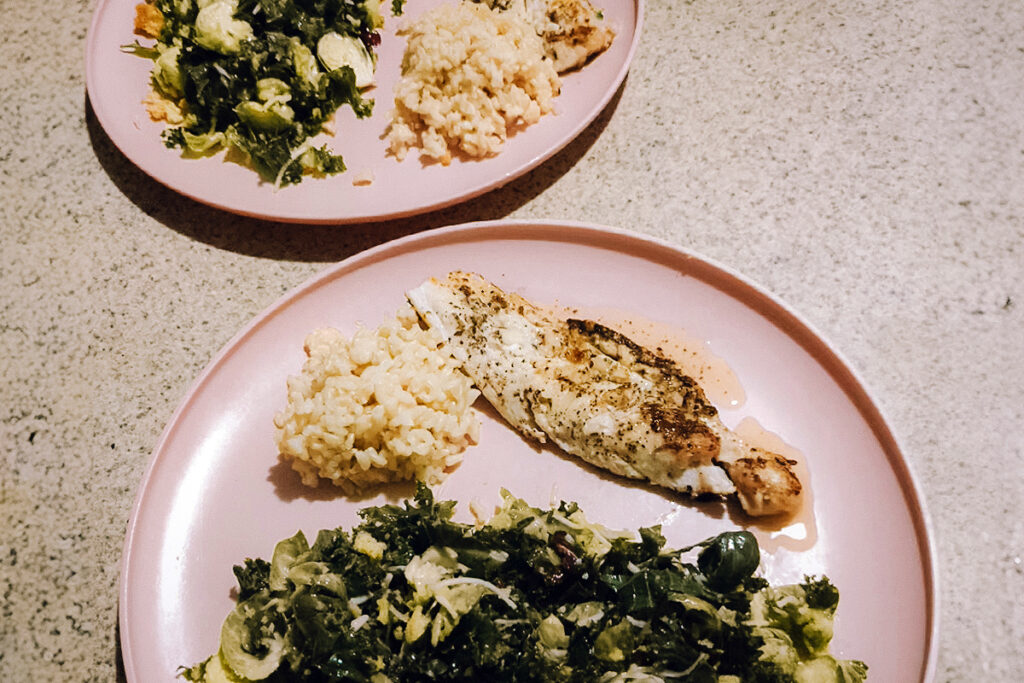
Personalized meal planning
One of the program’s best features is the ability to customize your meal plan. Weight loss programs are often rigid about food selections, but we liked that the Mayo Clinic Diet offers lots of flexibility. When you pick out your meals, you can customize your plan to make it realistic and ideal for your diet.
This feature makes it easy to accommodate different budgets and dietary preferences. Our tester found it easy to swap out recipes and ingredients to find something that suited her lifestyle. However, she did find the process to be time-consuming.
From our tester
“Weight-loss plans can be daunting, but this one is truly approachable. That said, plotting out my meals is still taking a fair amount of time. I’ve spent about 30 minutes swapping out recipes to find a week’s worth of meals I could actually see myself eating.”
But, for all the time you spend on meal planning, you save grocery planning. MCD has a built-in grocery list, so when you pick your meals, the list automatically populates with the ingredients you’ll need. This feature makes prepping easier and can make all the difference to someone changing their diet.
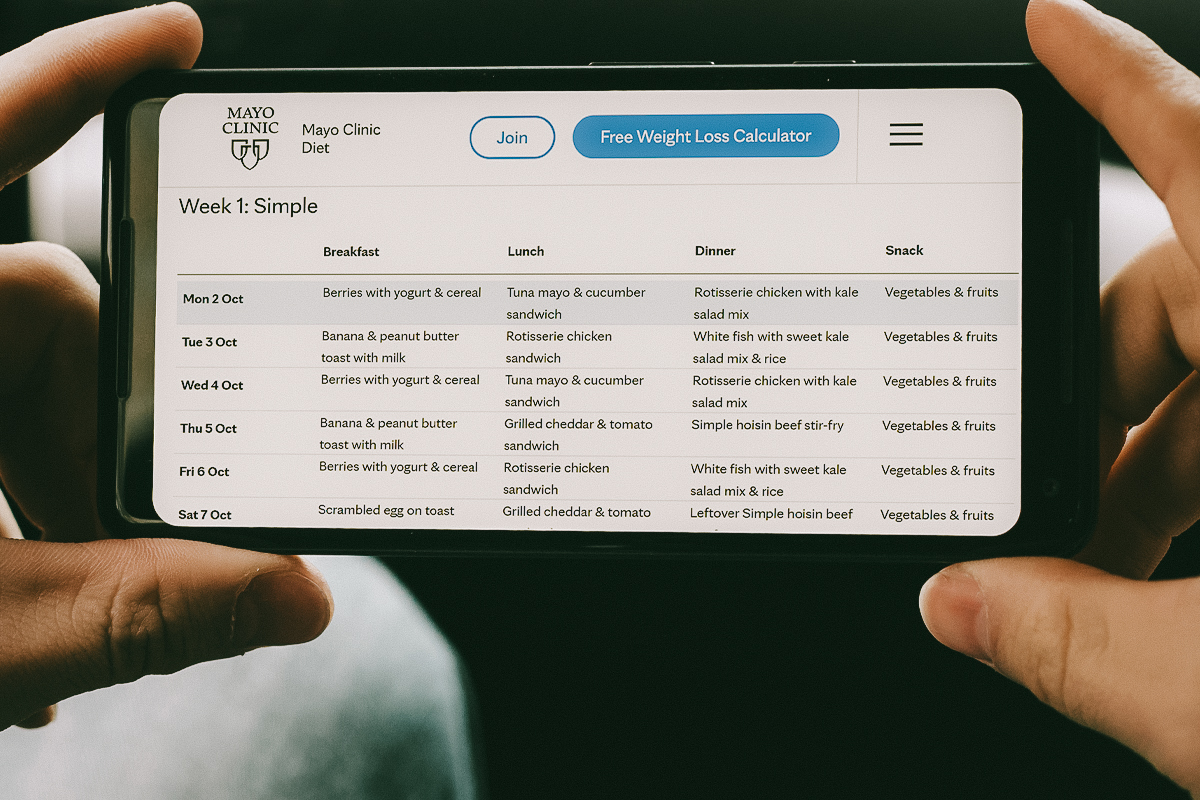
Community in the private Facebook group
The Facebook group is a major perk of the MCD. It’s the one place within the program that offers community and support. It is very easy to access the Facebook group—various places on the website and app direct you there. There are over 16,000 members, and you can post or interact with others via comments or reactions.
The Facebook group also has a Mayo Clinic moderator who responds to posts and offers valuable in-depth advice and tips. If you ever need additional support, have a question, or just want to vent, you can turn to the group.
What we don’t like
Snacking on only fruits and vegetables is challenging
Healthy snacking can benefit your health by boosting energy, curbing your appetite, preventing overeating at your next meal, and providing extra nutrients. The MCD discourages you from snacking on any food that isn’t a plain fruit or vegetable, but consuming high-protein snacks can preserve muscle mass.
Also, fruits and vegetables aren’t easily accessible for some people. They can be more expensive than other snacks, and since many have to be refrigerated or prepared, they aren’t the best on the go. “If someone must forgo a social gathering or force themselves to push through hunger because they don’t have carrot sticks on hand, this is not ultimately a supportive approach to health,” says Liz Wyosnick, a registered dietitian nutritionist and founder of Equilibriyum.
There are healthy snacks that aren’t fruits and vegetables, like unsalted nuts and seeds, veggie-based smoothies, and fat-free or low-fat cheese or yogurt. Our testers think a better approach would be for MCD to teach users how to choose healthy snacks and serving sizes instead of restricting snacking, which was counterproductive and challenging for our testers and members of the private Facebook group.

Lack of guidance and support
Our testers found an overall lack of guidance and support throughout the program. In the app, there are no pop-ups to direct you where to go or what to do. It’s up to you to explore and figure it out. Although the program is simple, the lack of direction can be confusing and frustrating.
Additionally, while you can participate in unlimited group coaching sessions, it is difficult to access them. Two group coaching sessions were available to us during testing: “Meal planning for success” and “Exercise: Can you outrun a bad diet?” Both of these sessions were available at 12 p.m. and 5 p.m. EST. According to the Facebook group, many people found that these times were not realistic with their schedules. The sessions are only available on the website, making them less accessible for people who mostly use the app or are on the go.
The group sessions offer little coaching but information on healthy nutrition. They’re lecture-style with a brief Q&A at the end. Other than asking a question or two, receiving personalized guidance can be difficult. If you have a chronic health condition or exercise limitations, having a personal coach who can guide you during your wellness journey is beneficial.
The monthly Open Office Hours allow you to ask questions, but many people in the Facebook group were unaware of this offering and didn’t know where to find it. The Open Office Hours are listed with the group sessions, and you can register ahead of time. You may receive some personalized guidance there depending on how many people attend.
The MCD also doesn’t offer words of encouragement or other positive reinforcement sprinkled throughout the app or website. Encouragement can make a big difference during a weight loss journey, especially if users struggle with motivation.
Exercises could be more accessible
At first, the MCD workouts seemed accessible. You don’t need any equipment and can do all the exercises at home. One of the scheduled exercises was 30 minutes of cardio of your choice, which lets you choose something realistic and comfortable for you. However, the MCD doesn’t offer alternatives to their recommended exercises, so some people may miss a crucial part of the program.
In the Facebook group, one member commented that they could not do the exercises due to physical limitations. They said, “I can’t get on the floor, stand and stretch, or do any of the recommended exercises, so I just skip them. They say you can modify them but don’t provide adequate guidance about how.”
Luckily, some community members chimed in with advice to walk or swim as a replacement. However, the MCD should consider the accessibility of their exercises and offer modifications or alternatives.
What is the Mayo Clinic Diet?
MCD is a weight-loss approach curated by medical professionals that provides the tools and education to learn more about your nutrition, habits, and overall health. The Mayo Clinic, a trusted medical organization, backs the diet. There is also a specific program adapted for people with prediabetes or type 2 diabetes called the Mayo Clinic Diet for Diabetes.
It’s a great program for beginners new to healthy living. Nothing is complex about this diet plan—it emphasizes a program of whole foods, fruits, vegetables, and exercise.
From our tester
“So much of what I tell my friends when they ask me about weight loss is that healthy eating isn’t marketable: It’s simple and boring. Eat whole foods, get in a lot of fiber to fill yourself up, and support digestion with fruits and vegetables. Eat a little less, move a little more. That’s the Mayo Clinic Diet in a nutshell. If you’re looking for a flashy weight-loss plan, this isn’t it. If you’re looking to learn more about healthy eating for life, this provides an approachable introduction. Yes, you will have to give up junk food. But…that makes sense!”
While the diet is simple, it can be restrictive, requiring you to make quick, substantial dietary changes. In the first few weeks, you will be asked to make five habits, break five habits, and adopt five bonus habits. Most of these new goals can be accomplished just by following the diet plan. They include:
- Five habits to make: Eat a healthy breakfast, eat vegetables and fruit, eat whole grains, eat healthy fats, and move for 30 minutes each day.
- Five habits to break: Watching TV while eating, consuming sugar or alcohol, snacking on anything except vegetables and fruits, eating too much meat and dairy, and dining at restaurants that don’t fit within the confines of the program.
- Five bonus habits: Eat “real food,” keep food records, keep activity records, move 60 minutes each day, and write your daily goals.
Although it’s a small thing, we appreciated the language of using “habits to make and break” instead of “healthy habits” and “unhealthy habits.” This small difference avoids placing shame on the user and makes the habits actionable instead.
Phases of the program
The program is separated into three phases: Lose It!, Live It!, and Love It!
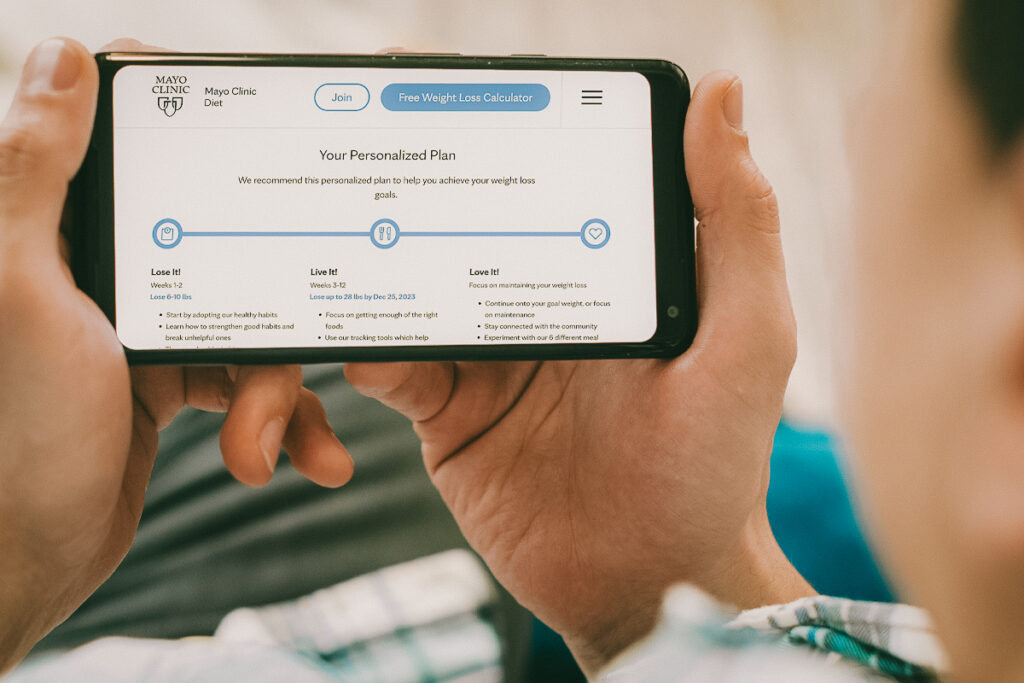
Lose It!
The first phase, Lose It!, lasts two to three weeks. In these first few weeks, we became familiar with the weight loss app and website, identified habits that we could make and break, participated in group coaching sessions, and started meal planning using the MCD’s guidelines.
The diet plan is pretty restrictive. You can’t consume added sugar, alcohol, or snacks (other than fruits and vegetables), and you should limit your consumption of dairy and meat. This is likely a drastic change from your usual routine and can be difficult to adjust to, especially if you eat out frequently. “The strict overarching rules of the MCD—like avoid eating out, avoid snacks unless vegetables or fruit, and avoid added sugar—are all good rules to follow in theory for weight loss. However, I find that many people need a more personalized approach to these factors,” says Wyosnick.
The MCD claims you will lose six to 10 pounds during this first phase. At first, this may sound like a lot. However, according to Keith Ayoob, pediatric nutritionist and clinical practitioner at Albert Einstein College of Medicine, some people may lose this weight during the first two weeks of the program because most of the weight loss is water weight. When you start dieting, you likely consume less sodium than usual, which can cause the total water mass in your body to decrease. In turn, your overall weight decreases.
However, losing this amount of weight so quickly depends on your body and size. Normally, rapid weight loss is not recommended since it isn’t sustainable. After the initial two weeks of the MCD, the emphasis shifts from rapid weight loss to gradual weight loss and maintenance, which is more sustainable.
Live It!
The Live It! phase is when the shift from rapid to gradual weight loss occurs. During this phase, you can expect to lose one to two pounds per week until you reach your goal weight.
The focus of Live It! is to implement the new habits you learned into your lifestyle. You continue to use the food and weight tracker and eat meals according to the MCD guidelines, but there is more flexibility. You can use these tools as needed, and you also have the option to try a different MCD meal plan or “freestyle” your meals instead. The goal is to realistically implement a healthy diet into your life, including learning to make healthy choices when dining out.
Love It!
Once you reach your goal weight, you will learn to maintain it in the Love It! phase. After six months of using the program, you do a quick recalibration by returning to the restrictive diet you followed in the Lose It! Phase. You’ll follow a strict diet plan, log your meals, and record your habits for five days.
This check-in aims to reinforce the healthy habits you learned in the first two phases so you can maintain the weight loss you achieved.
How does the Mayo Clinic Diet work?
The Mayo Clinic Diet consists of education, meal planning, group coaching sessions, and access to a community via a private Facebook group.
Sign-up begins with a quick weight loss calculator to determine your suggested weight loss goal. Afterward, you choose your subscription plan, enter your payment information, and create an account. Although you can use either the website or the app for the program, we recommend using the app. We found the website overwhelming and more difficult to navigate than the app.
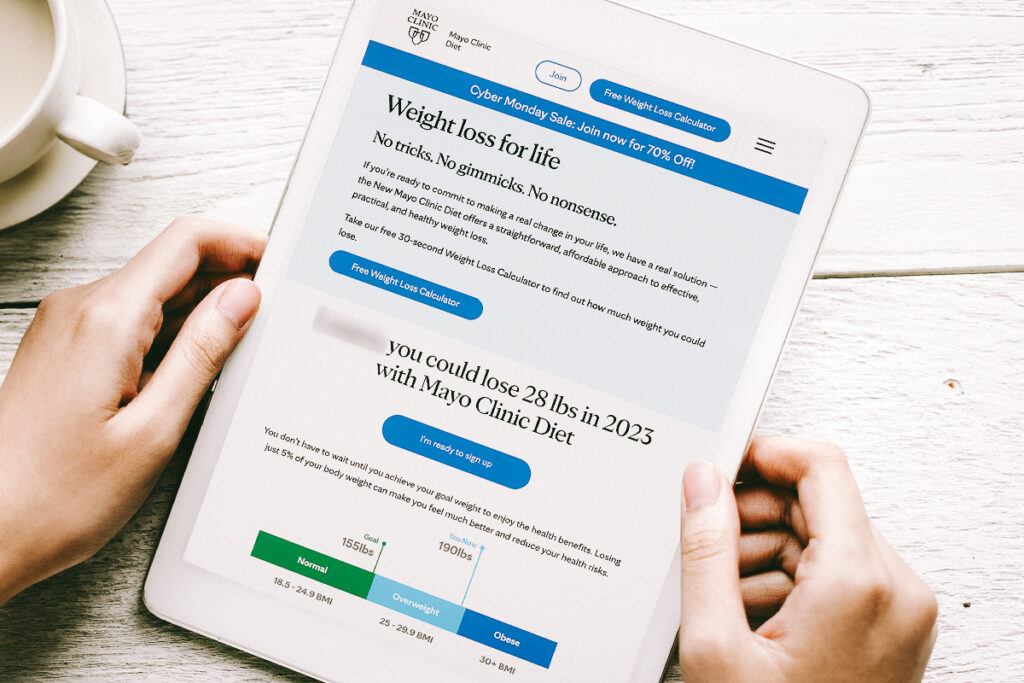
When you sign up, there are six meal plans to choose from:
- The Original Mayo Clinic Diet
- Simple
- Higher protein
- Healthy keto (high-fat, low-carb diet—daily net carbs are around 50 grams)
- Vegetarian
- Mediterranean (plant-based meal plan featuring fish, nuts, legumes, and unlimited fruits and vegetables)
You can choose to make the Original Mayo Clinic Diet, Simple, and Mediterranean diet plans gluten-free. And if you want to try something new later in the program, you can switch meal plans.
We chose the Simple meal plan, which was as easy as it claimed to be. The cooking instructions were clear, and our pantry already had the required ingredients. Some recipes called for more expensive ingredients, like avocado or berries, but plenty of recipes contained low-cost items, like canned tuna and chopped salad kits.
After signing up, the program will send you a long checklist of items they recommend completing before you start the program. This beginning process was a little overwhelming. Some items, like “Go grocery shopping,” are more time-consuming than others, like “Join the Facebook private group.” Before assigning you this checklist, the MCD suggests giving yourself time to prepare. We highly recommend that you take that time rather than starting immediately.
Once you’re all set up, your day-to-day routine will include meal planning and exercising. You can also participate in other activities like group coaching and interacting with the community in the private Facebook group.
How much does the Mayo Clinic Diet cost?
When it comes to the cost of the Mayo Clinic Diet, you have the option to pay for the entire subscription plan upfront, or you can pay on a monthly basis.
There are three different month-to-month plans to choose from:
- 12-month plan: $19.99 per month
- Three-month plan: $39.99 per month
- Six-month plan: $29.99 per month
Or you can choose to pay upfront for additional savings:
- 12-month plan: $199.99 ($40 less than the month-to-month plan)
- Three-month plan: $99.99 ($20 less than the month-to-month plan)
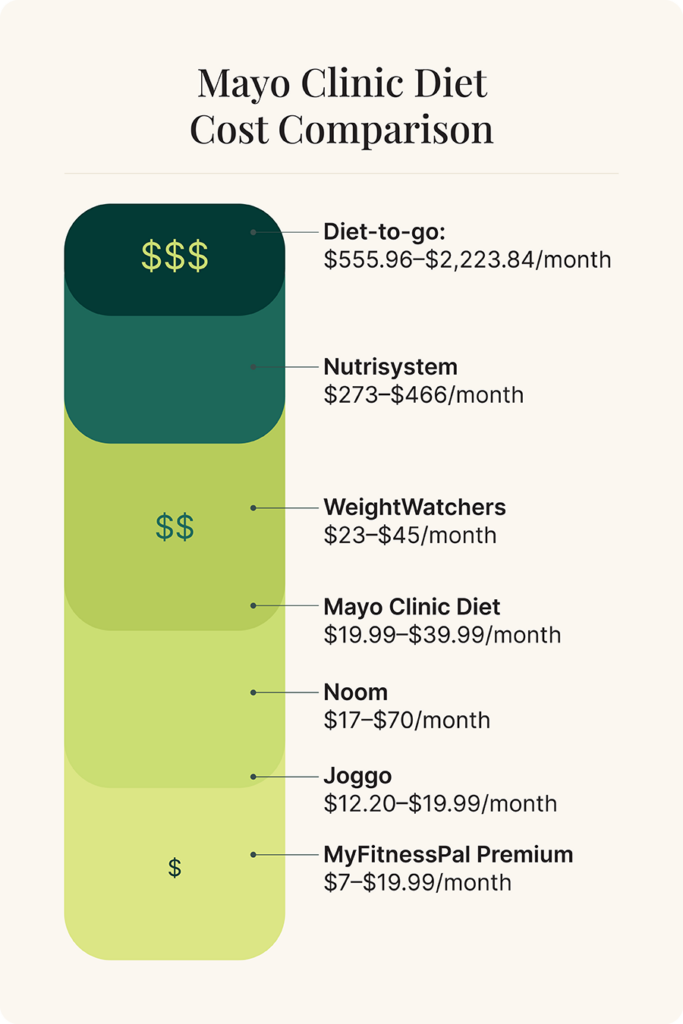
While the Mayo Clinic Diet is much less expensive than Nutrisystem, our tester appreciated the variety of food choices, well-packaged meals, and user-friendly app in the meal delivery service.
Key features of the Mayo Clinic Diet
Can you lose weight using the Mayo Clinic Diet plan?
Based on our research and interviews, you can lose weight using the Mayo Clinic Diet. Many customer reviews on Trustpilot reported losing weight because of the MCD. In the reviews we read, various users reported losing between eight and 32 pounds (over varying time frames).
We also interviewed past and current users of the platform, many of whom had positive things to say.
The first thing that struck me was the emphasis on adopting new, healthy habits rather than obsessing over calorie counting. With the guidance of the Mayo Clinic’s approach, I lost eight pounds in the first two weeks and have continued steadily since.
Amy Smith, from Portland, Oregon.
Who is the Mayo Clinic Diet best for?
The Mayo Clinic Diet is best for people eager to learn more about living a healthy lifestyle and who need a restrictive approach to hold them accountable. If the restrictions end up causing you more harm than good, you may need a program that has more flexibility, like Noom, or you may consider working with a dietitian or nutritionist. The Mayo Clinic Diet is also great for anyone who doesn’t have a ton of knowledge about nutrition and weight management.
If you have chronic health conditions or other circumstances that impact your diet and ability to exercise, you may need a more individualized approach to weight loss. Although you can customize the program to an extent, the Mayo Clinic Diet isn’t individualized. You would likely benefit more from meeting with a nutritionist or registered dietitian.
If you are experiencing signs of an eating disorder
First, know that you are not alone. Eating disorders affect people all over the world. In fact, 9 percent of people worldwide have an eating disorder. The Association of Anorexia Nervosa and Associated Disorders (ANAD) has the following resources available to people who are experiencing signs and symptoms of an eating disorder:
- Call the Eating Disorders Helpline at 888-375-7767, available Monday through Friday from 9 a.m. to 9 p.m. (unavailable on most major holidays).
- Join a virtual peer support group—there are general support groups and focused groups for LGBTQ+, BIPOC, caregivers, older adults, teens and young adults, siblings, people with larger bodies, men, and binge eating disorder.
- Request a mentor for free using the Recovery Mentorship Program.
- Browse the treatment directory to find a provider that specializes in eating disorders.
These resources can be helpful, but ultimately, you should talk to a health care provider about the symptoms you are experiencing. “I’d suggest contacting a registered dietitian or therapist/counselor with experience in treating disordered eating and eating disorders. This is important because not many registered dietitians and therapists may know how to recognize the red flags and address the issues,” says Karin Evans, registered dietitian nutritionist at Top Nutrition Coaching.
Our final verdict
The Mayo Clinic Diet contains the bread and butter of healthy living: Eat whole foods, limit your portion sizes, and be physically active. It is approachable and easy to follow, making it an excellent program for beginners. However, there could be improvements in accessibility and support, which are necessities for a weight loss program.
The MCD meal plan is customizable, which makes it easier to stick to. But, the diet can be restrictive, especially during the first phase of the program, and you’ll likely make big lifestyle changes.
Weight loss programs are not the best choice for everyone. Before you sign up, talk to your health care provider; they will help guide you on your healthy living journey.
FAQ
Some people may find the first two weeks of the Mayo Clinic Diet restrictive. Depending on your usual routine, you may have to make drastic changes, like cutting out alcohol, sugar, and snacks.
The Mayo Clinic Diet consists of tools to track your progress, unlimited group coaching sessions, access to a private Facebook group, and two eBooks (The Mayo Clinic Diet 3rd Edition and Cook Smart, Eat Well).
The program is designed for sustainable weight loss over several months. However, the first two weeks may be challenging since there are more restrictive rules.
- How to boost mental health through better nutrition. (2023, April). American Society for Nutrition. Link
- Eat healthy. (2022, July). MyHealthfinder. Link
- Benefits of healthy eating. (2021, May). Centers for Disease Control and Prevention. Link
- Benefits of physical activity. (2023, August). Centers for Disease Control and Prevention. Link
- Ingels, J. S., Zizzi, S. (2018). A qualitative analysis of the role of emotions in different patterns of long-term weight loss. Psychology & Health, 33(8),1014-1027. Link
- The science of snacking. Harvard T.H. Chan School of Public Health. Link
- Carbone, J. W., & Pasiakos, S. M. (2019). Dietary protein and muscle mass: translating science to application and health benefit. Nutrients, 11(5), 1136. Link
- Healthy snacking. American Heart Association. Link
- Kang, H. J., Jun, D. W., Lee, S. M., Jang, E. C., & Cho, Y. K. (2018). Low salt and low calorie diet does not reduce more body fat than same calorie diet: a randomized controlled study. Oncotarget, 9(9), 8521–8530. Link







